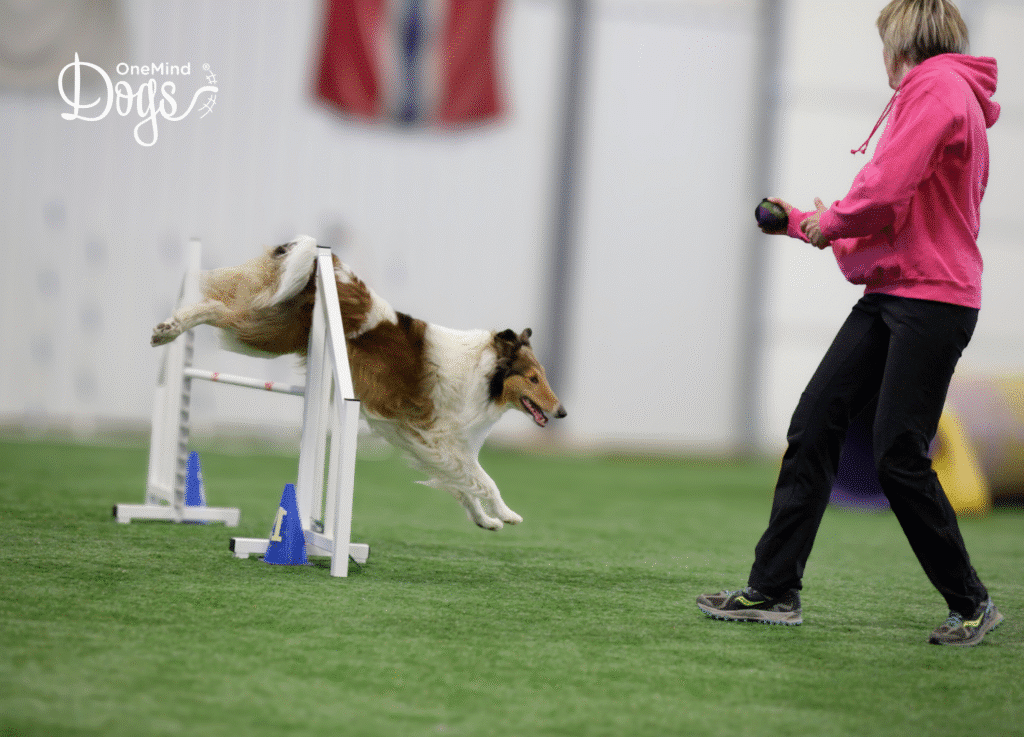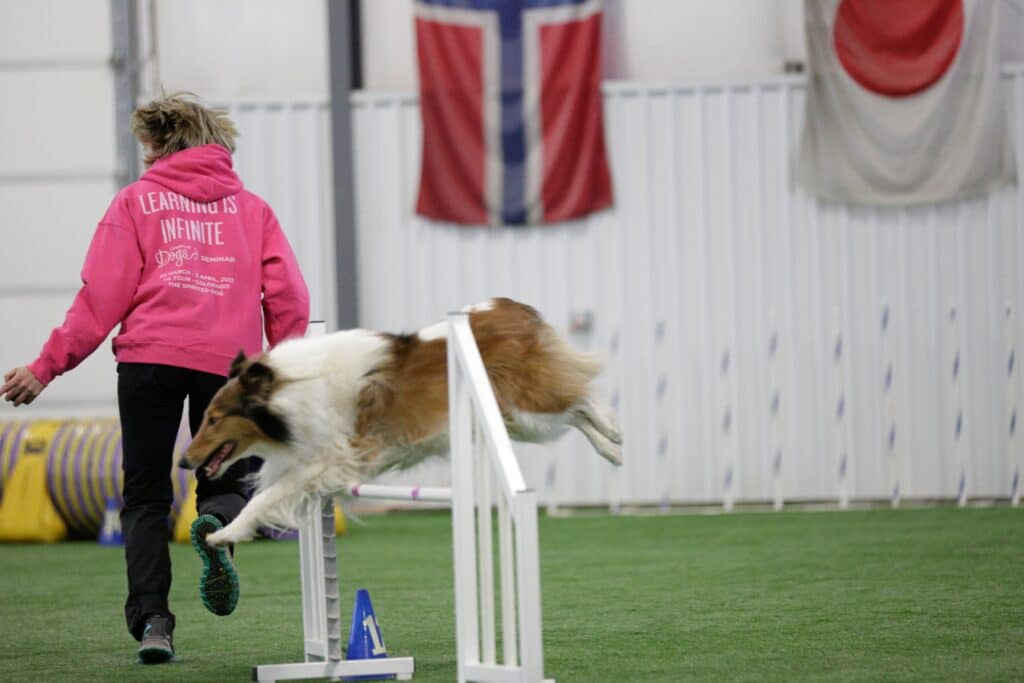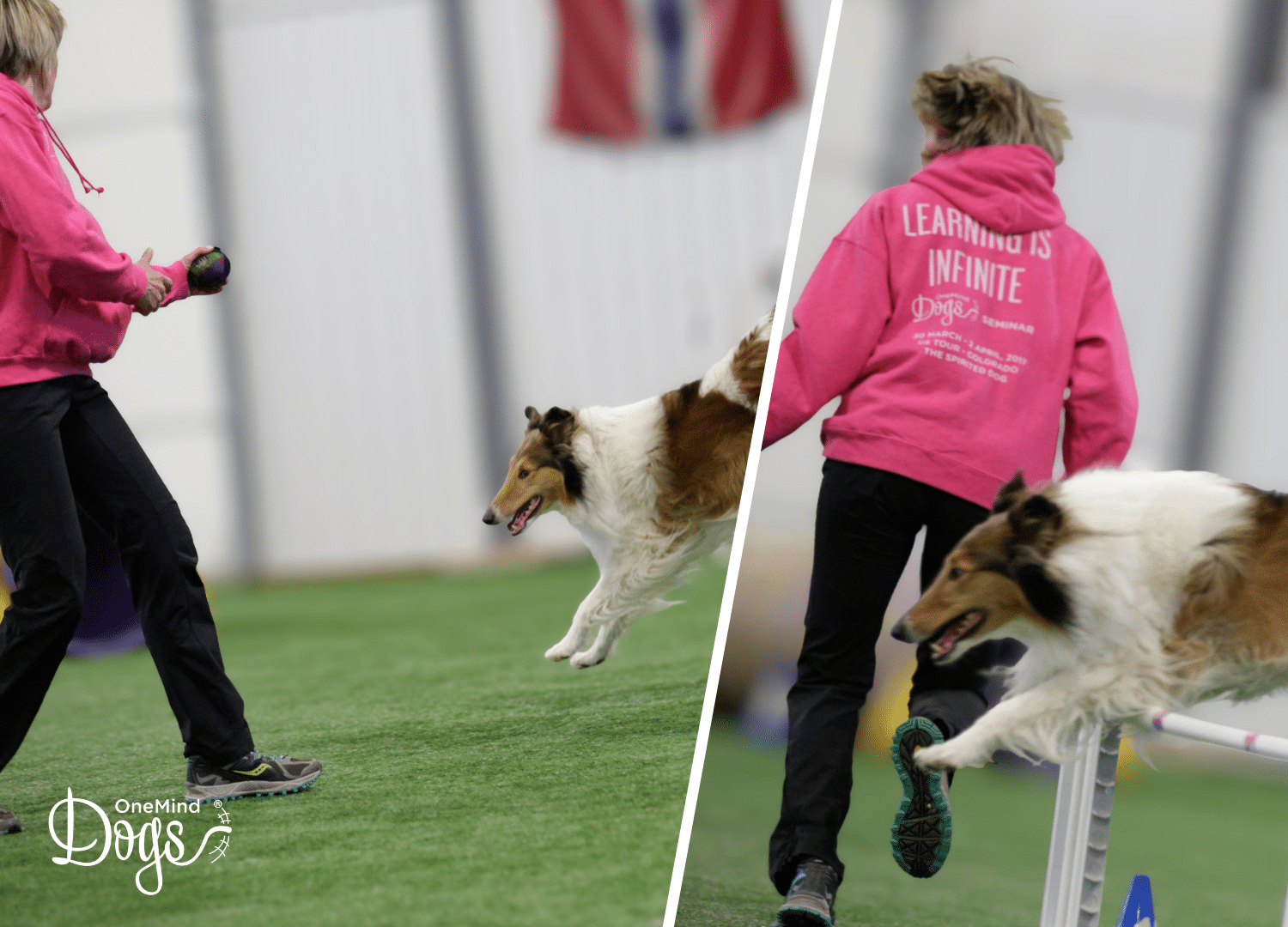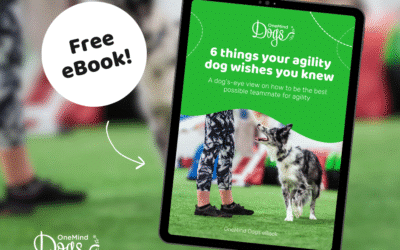If you’ve ever walked a course and asked yourself, “Should I do a Front Cross or a Blind Cross here?”, you’re not alone. Even the most experienced handlers find themselves second-guessing in those moments.
The real key isn’t about what feels easier for the human, but what makes the most sense for the dog.
At OneMind Dogs, everything we teach starts from the dog’s perspective. That means understanding how your dog reads your 7 handling elements to make sense of what’s next. In agility, those tiny details shape your dog’s confidence, speed, and ability to stay on a clean line.
That’s what this topic is all about, and why OneMind Dogs Coach Katelyn Scott created our free webinar:
👉 Front Cross vs Blind Cross: How to Choose the Right Handling Technique
In this webinar, Katelyn breaks down how your choices influence your dog’s path, and how to make the right call before they take off for the jump. Complete with video example and course map analysis!
Why the dog’s perspective matters
From your dog’s point of view, a course is a flow of movement, rhythm, and clear physical cues. They don’t understand verbal labels like “front cross” or “blind cross.” They only see your motion.
A Front Cross says:
➡ “There’s a turn coming up — collect and prepare to change direction.”
A Blind Cross says:
➡ “Keep driving forward — the line continues with flow.”
Both are great tools. The difference lies in when and how they cue your dog.
A Front Cross naturally creates collection, your dog shortens their stride and turns tighter. A Blind Cross cues extension, your dog lengthens their stride and accelerates forward on a more open line.
So the question isn’t “which cross is better?” but “which one gives my dog the clearest information for this moment on the course?”
Why timing is critical with Front and Blind crosses
Dogs can only make changes to their path if they are one or more strides away from their take-off point. By the time your dog leaves the ground, their landing line is already locked in.
If your cues come too late, your dog can’t adjust mid-jump, they’ll either turn too wide, land off-balance, knock a bar or lose confidence in what you’re asking.
That’s why the timing of your Front or Blind Cross matters so much. The goal is to give information early enough that your dog can make smooth, confident adjustments without second-guessing.
When your handling is early and clear, your dog feels like they’re reading the course with you — two souls with one mind.

A quick test you can try right now
So, how do you choose which handling technique to use on a course? Next time you’re walking a sequence, try this simple “V-test” from Katelyn’s webinar:
- Walk your dog’s real approach line to the jump.
- Stand where you’d be at commitment and make a small “V” shape with your feet pointing toward the next obstacle.
- If the next obstacle sits inside that “V,” a Blind Cross will work naturally.
- If it’s outside, your dog will understand the turn better with a Front Cross.
It’s a great way to visualize your dog’s perspective before you even step to the start line.
And if your dog’s actual running line doesn’t match what you imagined? Adjust your plan next time! The best handlers constantly update their choices based on what their dog is showing them — not what looks good on paper.
Understanding your dog’s natural reading of motion
Dogs are incredibly tuned in to motion. They notice changes in direction, rhythm, and even the smallest shift of your shoulders.
When you perform a Front Cross, you’re rotating toward your dog, momentarily facing them, and showing that the path is about to change. That’s a powerful cue to collect and prepare for a tighter turn.
A Blind Cross, on the other hand, keeps your back to your dog. You move ahead, change sides without stopping, and your dog naturally keeps extending forward because your motion never breaks their rhythm and they want to catch up with you.
From your dog’s perspective:
- Front Cross = “Slow down and prepare to turn.”
- Blind Cross = “Keep running, the path continues forward!”
Both are valuable, and both can be beautiful when done at the right moment. The secret is matching the technique to the information your dog needs.
Common mistakes (and how to fix them)
One of the biggest issues handlers face is late or unclear cues.
If your dog doesn’t know whether to extend or collect before takeoff, they have to guess. That’s when you see wide turns, dropped bars, or hesitation between obstacles.
Here’s how to fix that:
- Front Cross timing: move toward the obstacle first to get commitment, then use a small rhythm change (not a stop!) at least one stride before your dog takes off, before rotating. Keep your motion flowing along your dog’s next intended line. Learn more in this mini course.
- Blind Cross timing: The Blind Cross works best if you are far enough ahead of the dog to cross their line and turn your head before the dog takes off, giving them plenty of time to change their leading leg while staying in extension. Learn more here.
If Front Crosses feel awkward or rushed, it might not be about your speed at all, it could be your footwork or position. The good news? Those things are trainable! Watch the webinar to learn more!
Training for the dog’s clarity (not human convenience)
Many handlers choose a Blind Cross simply because it feels faster or easier to execute — but that doesn’t always mean it’s the clearest for the dog.
At OneMind Dogs, we always ask: what would the dog choose if they could decide?
For example:
If the dog is on a wide open line and the next obstacle continues smoothly in front, a Blind Cross makes perfect sense. It keeps flow and rhythm.
But if the dog needs to collect for a tighter turn, a Front Cross gives them earlier, clearer information about the change of direction. That clarity builds confidence and trust.
When your dog can rely on your cues, they run faster, not because you push them, but because they feel confident you’ll guide them right every time.

Building connection through movement
The most magical agility runs happen when handler and dog move as one, when your dog doesn’t have to question where to go next, because they already know from your body language.
Handling techniques are one of the most powerful tools to create that wordless understanding. Every movement, rotation, and step is a message to your dog. When you master Front and Blind Crosses from their perspective, it feels like dancing together — balanced, intuitive, and effortless.
That’s why the OneMind Dogs method teaches the seven handling elements as a universal language that all dogs understand. You can explore them inside our Method Program, where every cue is built around how dogs naturally read our body language.
Where to go next
If this topic sparked a lightbulb moment, you’ll love watching Katelyn’s full webinar:
🎥 Front Cross vs Blind Cross: How to Choose the Right Handling Technique
You’ll learn:
✅ When to choose Front vs Blind Crosses based on your dog’s natural understanding
✅ How to visualize your dog’s true line before handling
✅ Real examples of how tiny timing changes affect confidence and speed
It’s completely free, and you can watch the recording anytime.
Once you’ve watched, try Katelyn’s “V test” on your next training course and see how your dog responds. The difference in their confidence might surprise you.
Take it further with Agility Premium lessons
If you want to keep improving your timing, position, and connection, our Agility Premium program takes you far beyond the basics.
You’ll get access to:
- 700+ agility lessons, videos, and articles (from foundation to advanced handling)
- Guided courses with real coaching and community support
- Personal video feedback from our experienced instructors
- Exclusive webinars and all past recordings
- Training plans to help you progress with structure and purpose
And of course — full visual breakdowns of techniques like:
🎬 Take Your Front Cross to the Next Level
🎬 Blind Cross versus Front Cross comparison video
These lessons help you see the course through your dog’s eyes and move together with true connection.
The bottom line
There’s no single “right” cross that fits every situation. What matters is timing, clarity, and communication that your dog can understand.
When you start seeing each cross from your dog’s perspective, everything changes. You’ll notice smoother lines, happier runs, and a stronger sense of teamwork.
So next time you’re walking a course, pause for a second and ask yourself:
Does my dog need to extend or collect here?
The answer will tell you exactly which cross to use.



